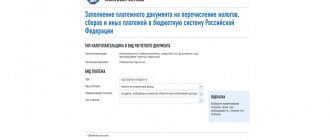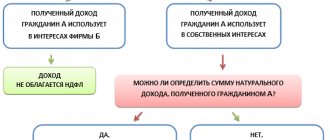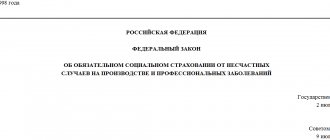Wages (employee remuneration) - remuneration for work depending on the employee’s qualifications, complexity, quantity, quality and conditions of the work performed, as well as compensation and incentive payments. From these payments, the employer is obliged to make mandatory payments to the budget - insurance premiums. People often ask: What is a contribution? What are insurance premiums? What types of insurance premiums are there? Where is the employer obliged to pay them, and what liability can he incur for non-payment? Answers to these questions in the article Firmmaker.
What are insurance premiums and when did they arise?
Insurance contributions are mandatory payments for compulsory pension insurance, compulsory social insurance in case of temporary disability and in connection with maternity, compulsory medical insurance, collected from organizations and individuals for the purpose of financial security for the implementation of the rights of insured persons to receive insurance coverage for the corresponding type compulsory social insurance (Article 8 of the Tax Code of the Russian Federation).
Compulsory social insurance is part of the state system of social protection of the population, the specificity of which is the insurance of working citizens, carried out in accordance with federal law, against possible changes in financial and (or) social status due to reaching retirement age, disability, loss of a breadwinner, illness, injury, accident at work or occupational illness, pregnancy and childbirth, the birth of a child (children), caring for a child under the age of one and a half years and other events established by the legislation of the Russian Federation on compulsory social insurance (Article 1 of the Federal Law No. 165-FZ of July 16, 1999) .
The history of insurance premiums is quite young. The emergence of social insurance was facilitated by the development of the economy and the emergence of labor relations, as a result of which employees began to need social protection. The first mentions of social insurance go back to the 19th century, at which time the Bismar Code of Imperial Laws appeared in Germany.
In Russia, a significant leap in the development of insurance was the abolition of serfdom. At this time, the first law in this area of insurance, “On the mandatory establishment of auxiliary partnerships at state-owned mining plants,” was adopted.
To ensure more progressive economic mechanisms and to regulate pension provision, the Pension Fund was created on December 22, 1990. Even before the formation of the Pension Fund, the budget was replenished from the general wage fund of organizations.
On January 1, 1991, the Social Insurance Fund was created, designed to regulate relations in the field of social insurance of citizens.
On February 24, 1993, the Health Insurance Fund was created to finance medical care.
Reduced insurance premium rates
In 2021, many previously provided benefits for individual entrepreneurs and legal organizations were cancelled. Thus, entrepreneurs engaged in work on patents were affected, as well as those who worked in the social and industrial fields, using a simplified taxation system.
Reduced tariffs remain for non-profit organizations involved in charity. In particular, this applies to those who carry out activities in the field of social services, conduct educational, outreach activities, and are engaged in science, culture or sports. They only have to transfer contributions to the Pension Fund, the amount of which does not exceed 20%.
Also, reduced tariffs are available to those organizations that operate in the field of information technology. These companies must meet the requirements specified in Article 427 of the Tax Code of the Russian Federation.
Related article: Features of voluntary pension insurance
If they fit the descriptions, then the insurance premium for them will have the following rates:
- OPS – 8%.
- Compulsory medical insurance – 4%.
- VNiM – 2%.
A significant reduction in contributions for compulsory medical insurance and VNIM is complemented by the opportunity not to make payments if the transferred funds exceed the limit values. Then OPS and VNIM are not accrued at the expense of the employer.
Knowledge of tax legislation is necessary for both employers and employees of their organizations. Payments under compulsory medical insurance, compulsory medical insurance, compulsory social insurance provide stability and guaranteed state support to the citizen, and for the employer they are a way to work honestly and openly. Understanding the principles of deduction of appropriate contributions can protect you from unpleasant overpayments in the future, and save money if the company qualifies for the reduced tariff program.
How are insurance premiums regulated?
- Chapter 34 of the Tax Code;
- Federal Law “On compulsory social insurance against accidents at work and occupational diseases” Federal Law No. 125-FZ dated July 24, 1998;
- Federal Law “On the Basics of Compulsory Social Insurance” No. 165-FZ dated July 16, 1999;
- Federal Law “On Compulsory Pension Insurance in the Russian Federation” No. 167-FZ dated December 15, 2001;
- Federal Law “On compulsory social insurance in case of temporary disability and in connection with maternity” Federal Law No. 255-FZ of December 29, 2006;
- Federal Law “On Compulsory Medical Insurance in the Russian Federation” Federal Law No. 326-FZ of November 29, 2010.
Who is required to pay insurance premiums
The policyholder who pays wages and other payments in favor of the insured persons is obliged to pay insurance premiums (clause 1 of Article 419 of the Tax Code). The policyholder pays insurance premiums from the organization’s funds, without deducting this amount from the employee’s salary.
In this case, the insurers include:
- organizations;
- individual entrepreneurs;
- individuals who are not individual entrepreneurs.
For example, individual entrepreneurs who have employees on their staff are required to pay insurance premiums from employee payments at generally accepted rates. Please note that in addition to insurance premiums for employees, individual entrepreneurs are required to pay insurance premiums for themselves (clause 2 of Article 419 of the Tax Code of the Russian Federation).
Reporting on insurance premiums
It is not enough to simply pay insurance premiums for yourself or your employees; you need to timely report for them to regulatory authorities. Otherwise, you will face a fine. All reporting can be classified and distributed as follows.
Federal Tax Service
Despite the fact that insurance premiums are not considered taxes, their calculation will have to be provided to the tax inspector every quarter, or more precisely by the end of the month following the quarter.
The calculation is submitted using the unified form KND 1151111. Includes at least 2 sheets where information about the taxpayer is filled out and calculations of contributions are provided. Supporting documents, for example, payment orders, are attached to the form.
Pension Fund
Only individual entrepreneurs and LLCs with employees report to the Pension Fund, but much more often - once a month, until the 15th day of the month following the reporting month. Form C3B-M is a form with a large table at the bottom of the page.
The taxpayer indicates his name and details, the reporting period, and most importantly, the list of employees. The table indicates their names, SNILS and TIN numbers. The fine for failure to provide is 500 rubles.
FSS
At the end of the quarter, a report is submitted to the Social Insurance Fund on form 4-FSS. Deadline: 20/25 of the next month (for paper/electronic). This is a rather voluminous form in which you need to indicate the average number of employees, the number of disabled people, calculations for accident insurance, and record cases of injury.
Types of insurance premiums
There are the following types of insurance premiums (Article 8 of the Tax Code of the Russian Federation):
- insurance contributions for compulsory pension insurance (OPI);
- insurance premiums for compulsory health insurance (CHI);
- insurance contributions for compulsory social insurance in case of temporary disability and in connection with maternity (VNiM);
- insurance premiums for injuries (accident insurance).
These types of contributions are calculated from wages and other payments accrued for each employee.
Other payments for which insurance premiums must be calculated and paid include (Article 420 of the Tax Code of the Russian Federation):
- bonuses;
- vacation pay and compensation for unused vacation;
- financial assistance over 4000 rubles. per employee per year.
Example 1. From what amount to calculate insurance premiums. Employee of Imperia LLC Ivanov I. I. was accrued the following payments for the month:
Type of payment Amount, rub. Base taxable tax-free Wage 10000 10000 0 Prize 5000 5000 0 Material aid 7000 3000 4000 Total 22000 18000 4000 Thus, insurance premiums must be paid from the amount of 18,000 rubles, i.e. from wages, bonuses and financial assistance over 4,000 rubles.
How to calculate the base for calculating contributions
Organizations and individual entrepreneurs separately calculate the base for each employee and for each contractor. The taxable base is calculated on an accrual basis from the beginning of the billing period, which corresponds to one calendar year. In other words, the base is determined during the period from January 1 to December 31 of the current year, then the calculation of the taxable base begins from scratch. The base is determined at the end of each month after salary calculation.
The taxable base for contributions in case of temporary disability and in connection with maternity should not exceed the maximum amount. Its value is approved by law and is indexed annually by decree of the Government of the Russian Federation. In 2021, the size of the maximum base is RUB 966,000. This means that contributions are accrued until the employee’s tax base reaches 966,000 rubles. Payments in excess of this amount are exempt from contributions. Starting in 2022, the countdown will begin again.
The pension contribution base is not limited. But for payments accrued in excess of the limit, a reduced rate is provided (see below). Thus, in 2021, the maximum amount for pension contributions is 1,465,000 rubles. After exceeding this amount, a reduced tariff applies.
The base for medical contributions and “injury” contributions is also not limited, and a reduced tariff is not provided here.
The total amount of contributions is equal to the taxable base multiplied by the corresponding insurance tariff (rate).
What payments are not subject to insurance premiums?
Payments not subject to insurance premiums include (Article 422 of the Tax Code of the Russian Federation):
- state benefits (unemployment benefits, temporary disability benefits, maternity benefits);
- severance pay, if this amount does not exceed three times the employee’s average monthly earnings;
- performance of work and provision of services under a civil law contract are not subject to insurance premiums for compulsory social insurance and injuries. But contributions for compulsory health insurance and compulsory medical insurance will have to be calculated;
- one-time financial assistance in connection with an emergency, natural disaster, in connection with the death of a family member, as well as in connection with the birth of a child. Please note that in order to provide financial assistance to an employee, it is necessary to issue an order and attach supporting documents to it, otherwise the inspection authorities may attribute these amounts to taxable insurance contributions;
- financial assistance up to 4000 rubles. per employee per year;
- amounts of payments under employment contracts and civil contracts in favor of foreign citizens and stateless persons temporarily staying in the territory of the Russian Federation, if these persons are not recognized as insured in accordance with the law.
How to calculate insurance premiums. Rates. Payment deadline
Insurance premiums are calculated monthly for each employee on the last day of the month, based on the base for calculating insurance premiums. And paid no later than the 15th day of the next calendar month. That is, insurance premiums for February must be paid no later than March 15. If the 15th falls on a weekend, then insurance premiums are paid on the next working day after the weekend. For example, insurance premiums for March must be paid before April 15, but since April 15 is a non-working day, payment is postponed to April 16.
You can pay earlier, but not later. However, if you are late in payment, you still need to pay as soon as possible, since penalties will then be charged for each day of delay.
Insurance premiums are calculated based on the rate and base for calculating insurance premiums. The base for calculating insurance premiums is defined as the amount of payments and other remunerations accrued separately in relation to each individual from the beginning of the year on an accrual basis (Article 421 of the Tax Code of the Russian Federation).
The 2021 rates and maximum base for each type of contribution are set as follows (see table). How the base of insurance premiums changed (graph)
| Base for calculating insurance premiums | Pension insurance | Social insurance | Health insurance | |
| Limit value of the base for the year | 1 465 000 | 966 000 | no max size | |
| Limit value of base per month=Base/12 months | 122 083 | 80 500 | no max size | |
| Bid | 22,00% | 2,90% | 1,80% | 5,10% |
| Contribution amount =Base*Rate | 322 300 | 28 014 | 17 388 | |
| Rate if the base is exceeded | 10% | 0% | 0% | 5,10% |
Example 2. An example of calculating insurance premiums. The organization LLC "Chocolate" (general taxation system, type of activity - sale of confectionery products) pays wages to employees, we will calculate the amount of insurance premiums for December.
Option 1 – the base for calculating insurance premiums did not exceed the established limit, the salary was 20,000 rubles. OPS = 20,000 rubles * 22% = 4,400 rubles. Compulsory medical insurance = 20,000 rubles * 5.1% = 1020 rubles. VNIM = 20,000 rubles * 2.9% = 580 rubles. Injuries = 20,000 rubles * 0.2% = 40 rubles. The Social Insurance Fund may set a different coefficient; for example, we take 0.2%. It depends on your main type of activity. You can find out which coefficient applies to your organization either from the “Notice on the amount of insurance contributions for compulsory social insurance against industrial accidents and occupational diseases” or directly from the social insurance fund. Option 2 - the base for calculating insurance premiums exceeded the established limit for compulsory health insurance and VNIM, wages amounted to 200,000 rubles. In this case, insurance premiums in case of temporary disability and in connection with maternity are not accrued or paid, contributions for compulsory pension insurance are paid at a rate of 10%. OPS = 200,000 rub. * 10% = 20,000 rub. Compulsory medical insurance = 200,000 rubles * 5.1% = 10,200 rubles. Injuries = 200,000 rubles * 0.2% = 400 rubles.
Insurance premium rates for employers in 2020
Previously, the Tax Code of the Russian Federation stipulated that the aggregate tariff of 30%, at which the majority of insurers calculate contributions, would be in effect temporarily - from 2021 to 2021 (Article 426 of the Tax Code of the Russian Federation). And after the specified period, the tariff for compulsory health insurance contributions should have increased by 4% to 26%, and the total tariff, accordingly, from 30% to 34% (subclause 1, clause 2, article 425 of the Tax Code of the Russian Federation as amended before 01/01/2019). However, legislators changed their minds. And the indicated basic contribution rates have become permanent since 2021.
In this regard, in 2021, in general, the following contribution rates are applied (clause 2 of Article 425 of the Tax Code of the Russian Federation):
- for OPS - 22% within the maximum base value and 10% if it is exceeded;
- at VNiM – 2.9%;
- for compulsory medical insurance – 5.1%;
- for injuries – from 0.2% to 8.5%.
The law also establishes so-called increased insurance premium rates. They are paid by employers with harmful (difficult, dangerous) working conditions. Additional contribution rates tariffs for 2021 and what they depend on are available in ConsultantPlus:
Organizations that have jobs with the right to early retirement from clauses 1 - 18, part 1, art.
30 of Law N 400-FZ. Specific names of works are given in special lists. Read completely. Also see the table with tariffs in K+ here.
In connection with the coronavirus, from April 1, 2021, small and medium-sized businesses (SMEs) pay contributions at reduced rates for payments exceeding the minimum wage (Article 5 and Federal Law dated April 1, 2020 No. 102-FZ). Their rates are:
- for OPS – 10%;
- for compulsory medical insurance – 5%;
- at VNiM – 0%.
Accordingly, payments not exceeding 1 minimum wage per month are subject to contributions at regular rates.
KEEP IN MIND
Federal Law No. 172-FZ of 06/08/2020 for organizations and individual entrepreneurs affected by coronavirus canceled (reset to zero) insurance premiums for the 2nd quarter of 2020 - from payments to individuals accrued for April, May and June 2020. For more information, see “Features of payment of insurance premiums by organizations and individual entrepreneurs for the 2nd quarter of 2020.”
But the 2021 rate of insurance premiums for insurance against industrial accidents and occupational diseases is simply not specified in the law. The fact is that it depends on the class of professional risk according to OKVED. How to determine the contribution rate for injuries is described in ConsultantPlus:
The rate of contributions for accident insurance depends on the class of professional risk to which your main type of economic activity belongs (Article 21 of Law No. ... (see decision in full).
Where are insurance premiums paid?
Insurance premiums for compulsory medical insurance, compulsory medical insurance, and in the event of VNiM are paid to the Federal Tax Service at the location of the organization, and insurance premiums for injuries are paid to the Social Insurance Fund . If an organization has a separate division in another city, then insurance premiums must be paid at the location of its parent organization. However, if a separate unit is vested with powers, then insurance premiums are required to be paid at the location of the separate unit. In this case, insurance premiums are paid based on the size of the base for this division.
Each type of insurance premium is paid in separate payment documents. Please pay attention to the correctness of the BCC, which you indicate in the payment order; it is different for each insurance premium.
Who is required to pay insurance premiums from wages?
Employers are required to pay contributions from employees' salaries. If an employment contract is concluded between a company and a citizen, the company is obliged to make the following deductions:
- to the social insurance fund in case of disability, maternity;
- to the compulsory medical insurance fund for medical insurance, as well as in the event of an employee receiving a professional injury;
- in the Pension Fund of the Russian Federation for employee pension insurance.
For employees working on the basis of a civil contract, the employer is also obliged to pay contributions. However, their list is limited. Deductions are made from the employee's salary for pension and health insurance.
Expanding the list of contributions for workers under the State Development Plan is possible if this obligation is reflected in the contract.
Important!
Individual entrepreneurs are required to make contributions themselves.
How is payment of insurance premiums verified?
The correctness and timeliness of payment of contributions is carried out through desk and on-site inspections. Since 2021, control over the payment of insurance premiums is carried out by the tax authorities, with the exception of contributions for injuries, these contributions are controlled by the Social Insurance Fund. We talked about this in detail in the article “Insurance Premium Reform.”
The Social Insurance Fund also retains:
- desk audits for reimbursement of social insurance funds at the request of the employer;
- Conducting on-site audits together with tax inspectors;
- consideration of complaints based on inspection reports.
Tax authorities monitor the correctness and timeliness of payment of insurance premiums using:
- desk audit of calculations of insurance premiums;
- reconciliation of accrued and paid amounts of insurance premiums;
- conducting on-site inspections, together with the Social Insurance Fund.
What documents may be required when checking insurance premiums?
Example 3. The organization Karat LLC (general taxation system, type of activity - wholesale trade in automobile parts) received a decision to conduct an on-site inspection, the subject of which was the correctness of calculation and timely payment of insurance premiums, as well as the legality of the expenses incurred by the policyholder for the payment of insurance coverage for 2014-2017.
The following documents were required for the verification:
- labor and civil contracts;
- employment orders;
- work books;
- time sheets;
- payroll, payslips for wages;
- personal cards of employees;
- certificates of incapacity for work;
- application and order for maternity leave, calculation of the amount of benefits;
- documents confirming payment of monthly maternity benefits (copy of birth certificate, application for leave, order, calculation of the amount of benefits, certificate from the father’s place of work stating that he does not receive benefits);
- orders for financial assistance and documents confirming the basis for its payment.
Also, the tax office and the Social Insurance Fund may request other documents related to the audit being carried out. On the day the inspection was completed, a certificate of the inspection was signed.
What responsibility does an employer bear for non-payment of insurance premiums?
In case of non-payment of insurance premiums, the employer bears tax, administrative and criminal liability.
Administrative liability for non-payment of insurance premiums - fine
Administrative liability for non-payment of insurance premiums is established only for officials of government agencies, as well as other organizations and institutions that keep budget records (Article 15.15.6 of the Code of Administrative Offenses of the Russian Federation). Administrative punishment is not directly provided for directors and other responsible persons of other organizations, although there is an opinion that they can be prosecuted under Art. 15.11 of the Code of Administrative Offenses of the Russian Federation, which establishes liability for non-payment of taxes and fees.
Tax liability for non-payment of insurance premiums - arrears, penalties, fines
They are brought to tax liability for non-payment, incomplete payment of contributions as a result of understating the base for calculating insurance premiums, and other illegal actions. This type of liability is the most common type of liability for non-payment of insurance premiums. And, as a rule, it entails simultaneously the collection of arrears (the amount of unpaid tax) from the employer and the accrual of penalties for each day of delay in payment, and also, at the same time, it is possible to impose a fine in the amount of 20% of the amount of unpaid insurance premiums, and if intentional non-payment - 40% of this amount. However, this penalty can be avoided. The Ministry of Finance clarifies the imposition of a fine for non-payment of insurance premiums in Letter No. 03-02-07/1/31912 dated May 24, 2017: “The inaction of the taxpayer, expressed solely in the failure to transfer to the budget the amount of tax specified in the tax return, does not constitute an offense, established by Article 122 of the Tax Code. In this case, penalties will be collected from the taxpayer.”
Thus, if you did not pay insurance premiums on time, but correctly reflected the accruals and submitted the calculation on time, no fine is imposed. You will only need to pay the arrears and accrued penalties. You can also avoid a fine if you incorrectly reflected the accruals, which led to an understatement of the tax base. To do this, you must first pay off the arrears and penalties that have arisen, and then submit an updated Calculation of insurance premiums. At the same time, the organization must detect the error before the tax office finds it and before it finds out that the inspectorate has ordered an on-site inspection (Article 81 of the Tax Code of the Russian Federation).
Example 4. LLC did not pay insurance premiums. The organization LLC "Ikra" (general taxation system, type of activity - wholesale trade in fish, seafood and canned fish) paid insurance premiums for March 2021 in the amount of 10,000 rubles. 05/17/2018 (instead of 04/16/2018), thereby delaying payment by 30 days. The tax office sent a demand for payment of arrears in the amount of debt - 10,000 rubles. and a penalty. In this case, the penalties will be equal to: 10,000 rubles. x 7.25% (refinancing rate in effect during the period of delay) x 1/300 x 30 days. = 72.50 rub. The employer incurred tax liability for non-payment of insurance premiums in the form of penalties. Arrears and penalties have different BCCs, so they must be paid using different payment documents.
Criminal liability for non-payment of insurance premiums - fine, arrest, imprisonment
Criminal liability is borne by employers who, as in the case of tax liability, did not pay (did not pay in full) insurance premiums, did not submit a calculation, or included knowingly false information in it, which resulted in a distortion of the tax base on a large or especially large scale . If the employer committed this crime for the first time and fully paid the fine, all amounts of arrears and penalties, then he is released from criminal liability.
This type of responsibility is quite young. The prospects for introducing criminal liability for non-payment of insurance premiums have been considered since 2013, however, the article defining this type of liability was introduced by Federal Law No. 250 - FZ only on July 29, 2021.
Criminal liability for individuals for insurance premiums (Article 198 of the Criminal Code of the Russian Federation):
- imposition of a fine from 100 to 300 thousand rubles or in the amount of wages for a period of up to 2 years;
- compulsory work for up to one year;
- arrest up to 6 months;
- imprisonment for up to one year.
If this act is committed on an especially large scale, then the individual is punished:
- a fine of 200 to 500 thousand rubles. or in the amount of wages for a period of up to 3 years;
- compulsory work for up to 3 years;
- imprisonment for up to 3 years.
Typical wiring
Let's consider the key algorithm for calculating CBs and reflecting them in accounting using a specific example.
VESNA LLC is an OSNO company that applies generally established tariffs for insurance coverage for citizens. The contribution rate for injuries is 0.2%. In January 2021, salaries of key personnel were accrued in the amount of 1,000,000 rubles. The accountant recorded the following actions:
| Operation | Debit | Credit | Amount, in rubles | Note |
| Salaries of key personnel accrued | 20 | 70 | 1 000 000,00 | Basis document: salary slips for January |
| Accounting entry if insurance premiums from wages are calculated for temporary disability and maternity | 20 | 69.1/1 | 29 000,00 (1 000 000 × 2,9%) | |
| Accrual of SV on OPS | 20 | 69.2 | 220 000,00 (1 000 000 × 22%) | |
| SV reflected on compulsory medical insurance | 20 | 69.3 | 51 000,00 (1 000 000 × 5,1%) | |
| Accounting entry if contributions are accrued to extra-budgetary funds for injuries (in the Social Insurance Fund) | 20 | 69.1/2 | 2000,00 (1 000 000 × 0,2%) | |
| The money was transferred to the Federal Tax Service and funds: | ||||
| VNiM | 69.1/1 | 51 | 29 000,00 | Basis document: payment orders, extract from a banking organization on the status of the current account |
| OPS | 69.2 | 220 000,00 | ||
| Compulsory medical insurance | 69.3 | 51 000,00 | ||
| NS and PZ | 69.1/2 | 2000,00 | ||
In February 2021, VESNA LLC received from the Federal Tax Service a requirement to pay arrears in the amount of 5,000 rubles and a penalty in the amount of 135.55 rubles. The accountant made the following entries:
| Operation | Debit | Credit | Amount, rub. | A document base |
| Penalty accrued | 99 or 91 (depending on the method specified in the accounting policy) | 69 (according to the corresponding subaccount) | 135,55 | Requirement of the Federal Tax Service |
| Penalty payment reflected | 69 (according to the corresponding subaccount) | 51 | 135,55 | Payment order |
| Arrears accrued | 20 - if the arrears were accrued for the current year; 91.2 - if the arrears were billed for previous reporting periods | 69 (according to the corresponding subaccount) | 5000,00 | Requirement of the Federal Tax Service |
| Payment of arrears | 69 (sub-account) | 51 | 5000,00 | Payment order |
IMPORTANT!
Fix the method of reflecting penalties in accounting in your accounting policy. It is permissible to assign penalties to 91 or 99 accounts. We talked about which account to choose in the article “Tax Penalties: Postings”.
Results
Insurance contributions are mandatory payments for compulsory pension insurance, compulsory social insurance in case of temporary disability and in connection with maternity, compulsory medical insurance, collected from organizations and individuals for the purpose of financial security for the implementation of the rights of insured persons to receive insurance coverage for the corresponding type compulsory social insurance.
These types of contributions are calculated from wages and other payments accrued for each employee monthly on the last day of the month based on the base for calculating insurance premiums. And paid no later than the 15th day of the next calendar month.
Insurance premiums for compulsory medical insurance, compulsory medical insurance, and in the event of VNIM are paid to the Federal Tax Service at the location of the organization, and insurance premiums for injuries are paid to the Social Insurance Fund.
In case of non-payment of insurance premiums, the employer bears tax, administrative and criminal liability.
Firmmaker, July 2018 (updated in January 2021) Olga Uss When using materials, reference is required
When and how to pay fees
Monthly mandatory payments for pension, medical contributions, “injury” contributions, as well as for insurance contributions in case of temporary disability and in connection with maternity are transferred no later than the 15th day of the month following the month for which the payment is accrued. Thus, the monthly payment for August must be transferred no later than September 15, the payment for September - no later than October 15, etc.
For each type of contribution you need to fill out a separate payment form. This rule also applies to social insurance contributions. So, for contributions “for injuries” and “for sick leave”, two independent payments should be issued.
If the last date for payment of contributions falls on a weekend or holiday, you can transfer the money on the first working day following it, and this will not be considered late.
“Individuals” transfer pension contributions within the following periods. Contributions in the amount of 32,448 rubles. must be paid no later than January 10, 2022 (the payment deadline is December 31, 2021, but this is a holiday). Contributions calculated from an amount exceeding RUB 300,000 must be transferred no later than July 1, 2022.
“Individuals” transfer medical contributions no later than December 31 of the current year. So, the amount is 8,426 rubles. must be transferred no later than January 10, 2022 (since December 31, 2021 is a holiday). And those who voluntarily insured themselves in case of temporary disability and in connection with maternity make transfers for this type of insurance no later than December 31 of the current year (4,452 rubles must be transferred no later than January 10, 2022, since December 31 2021 - day off).
Payments for pension and medical contributions, as well as contributions in case of temporary disability and in connection with maternity, must be made in whole rubles (an amount of less than 50 kopecks is discarded, and an amount of 50 kopecks or more is rounded up to the full ruble). Contributions “for injuries” are transferred in rubles and kopecks, without rounding.









